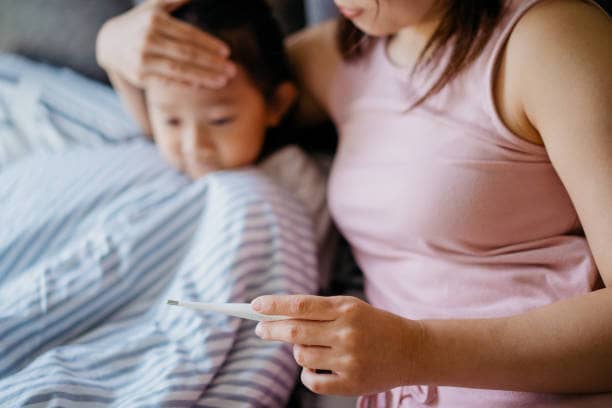
How to Reduce 104 Fever in Child?
It’s crucial to consult a physician if a child exhibits symptoms including shortness of breath, rapid breathing, poor oral fluid intake, or temperature above 104°F. In this article you will learn how to reduce 104 fever in child plus more.
When babies have difficulty breathing, it’s harder for them to breastfeed or drink from a bottle, and that puts them at risk for becoming dehydrated.
When a child’s temperature rises, parents may get concerned, but fevers are often harmless and even beneficial because they represent the body’s defense against illnesses.
What does a fever mean in a child?
A fever is generally defined as a temperature higher than 100.4°F (38°C). Depending on whether you take your child’s temperature via the mouth, axillary (underarm), ear, forehead, or rectal, you may receive somewhat different results.
What are the signs and symptoms of a fever?
High temperature (103° or 104° F), body pains, exhaustion, and upper respiratory symptoms, such as coughing, are commonly seen with influenza.
RSV often produces a runny nose and cough, but it can also cause fever in children, and 20% to 30% of infants have rapid breathing because of lower airway infection (bronchiolitis).
A child who has a fever might be:
- fussy
- uncomfortable
- warm to the touch
- flushed
- sweaty
What can I do about a fever?
If your child is younger than three months old and has a temperature of 100.4°F (38°C) or higher, call the doctor’s office.
A child with a fever should ideally be kept at home from daycare or school until their temperature has returned to normal for at least 24 hours.
Here are some strategies on how to reduce 104 fever in child:
- Offer plenty of liquids to avoid dehydration.
- Give acetaminophen or ibuprofen based on the doctor’s recommendations. Do not give aspirin to your child or teen as it’s linked to a rare but serious illness called Reye syndrome.
- Never use rubbing alcohol or cold baths to bring the fever down.
- Dress your child in lightweight clothing and cover with a light sheet or blanket.
- Let your child eat what they want, but don’t force it if your child doesn’t feel like eating.
- If your child also is vomiting and/or has diarrhea, ask the doctor if you should give a children’s oral rehydration solution (also called oral electrolyte solution or oral electrolyte maintenance solution).
- Make sure your child gets plenty of rest.
Get medical care if:
- your baby is younger than 3 months old has a temperature of 100.4°F (38°C) or higher
- an older child has a fever and:
- looks sick
- has lasting diarrhea and/or repeated vomiting
- has signs of dehydration (peeing less than usual, not having tears when crying, less alert and less active than usual)
- develops a rash
- has a fever for 5 days
- has a chronic medical problem like sickle cell disease or cancer
Can fevers be prevented?
Every child occasionally gets a fever, but most of the time they recover completely in a few days. Until the fever subsides, the most important thing is to keep your child as comfortable as possible and seek medical attention when necessary.
However, one of the most effective strategies to avoid a fever is to limit your exposure to infectious organisms. Body temperature typically rises when exposed to infectious pathogens.
The following advice can assist in lowering your exposure: Wash your hands frequently, particularly before consuming food, following a restroom visit, and following a large gathering of people.
What is the first aid for 104 fever?
Treating fever in an adult: Adults with fevers of 103 F (39.4 C) or higher will generally look and act sick. The main goal of treatment is to relieve discomfort and help you get rest. To treat a fever at home: Drink plenty of fluids to stay hydrated.
How can I reduce my child’s 104 fever at night or while sleeping?
- Give them a sponge wash that is just barely warm (but stop immediately if your child begins to shiver).
- Make sure they are consuming plenty of fluids to maintain their hydration levels.
- Reduce the temperature in the room and dress them in light clothing.
- Let them sleep; generally speaking, you shouldn’t wake a youngster who is asleep to administer fever medication.
- Give acetaminophen or ibuprofen based on the doctor’s recommendations.
- Never use rubbing alcohol or cold baths to bring the fever down.
Does a fever mean a child is contagious?
When a child has a fever, they often have a viral illness and are most infectious. Schools have certain policies on this, stating that children must be fever-free and medication-free for a full day prior to being allowed back in the classroom.